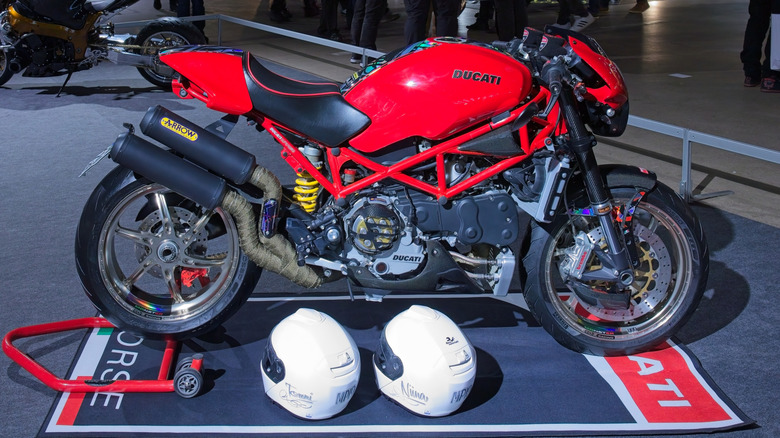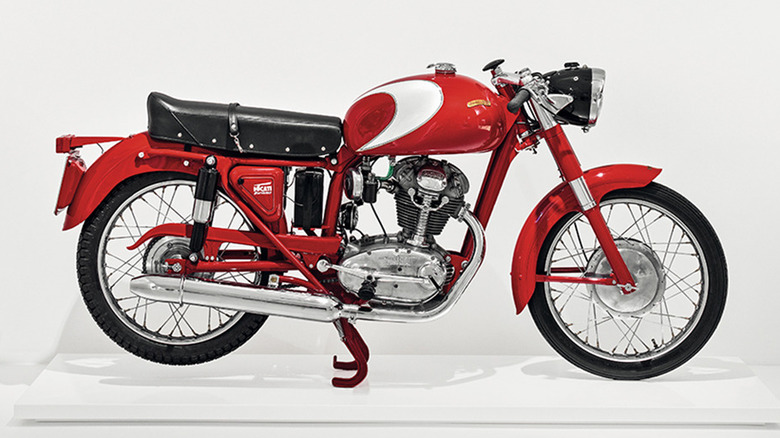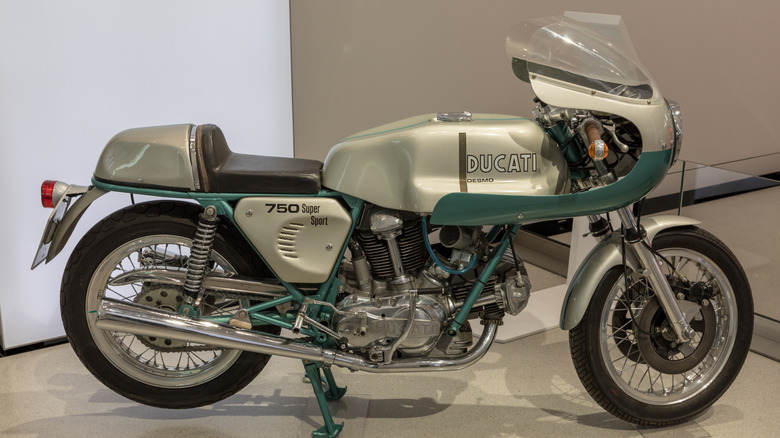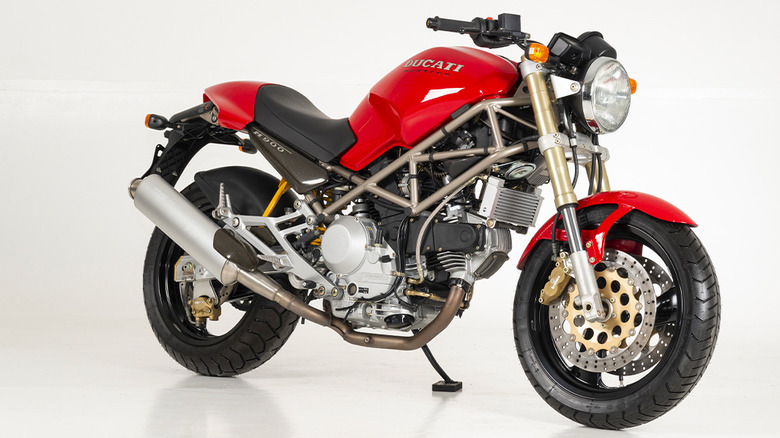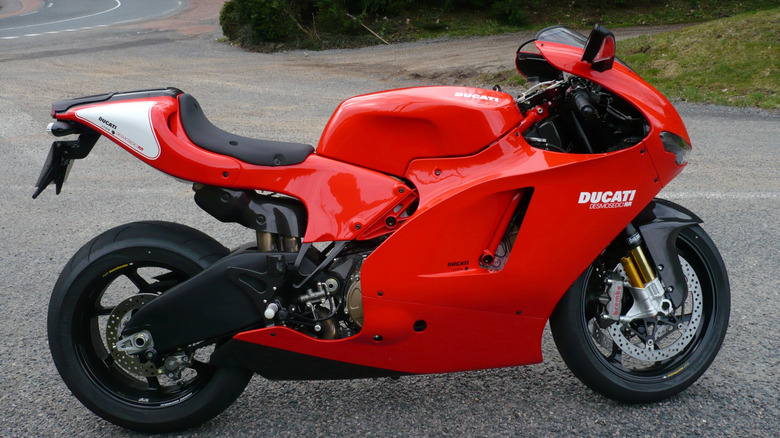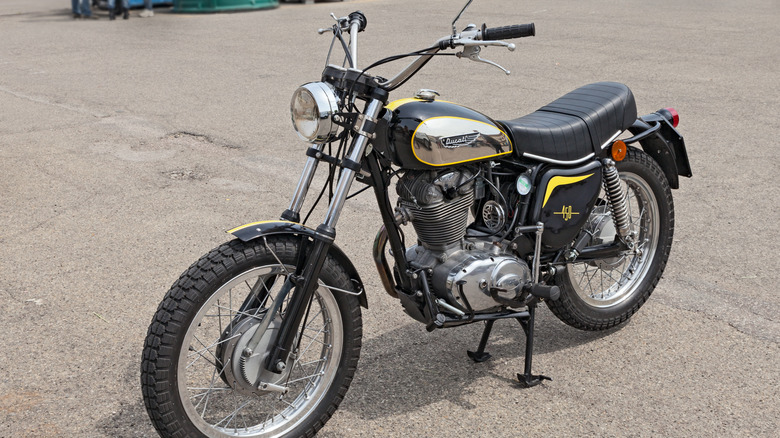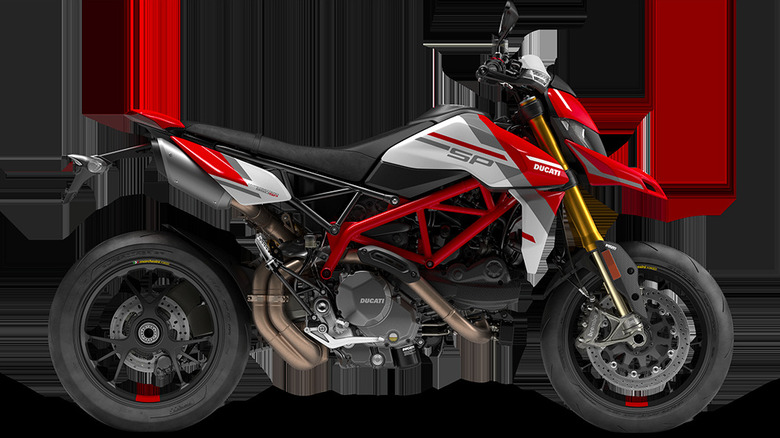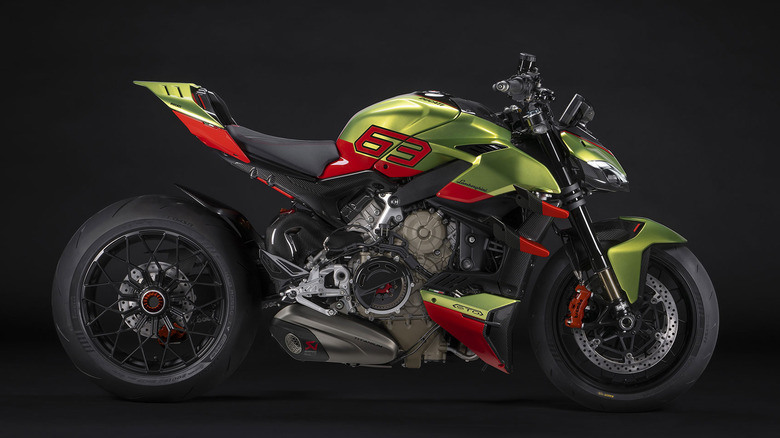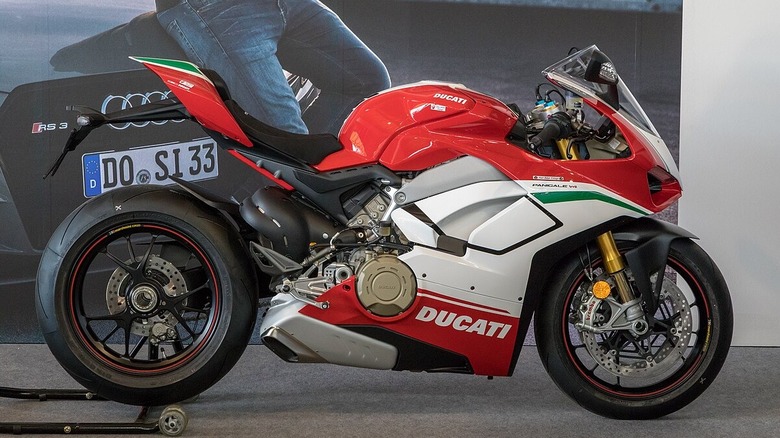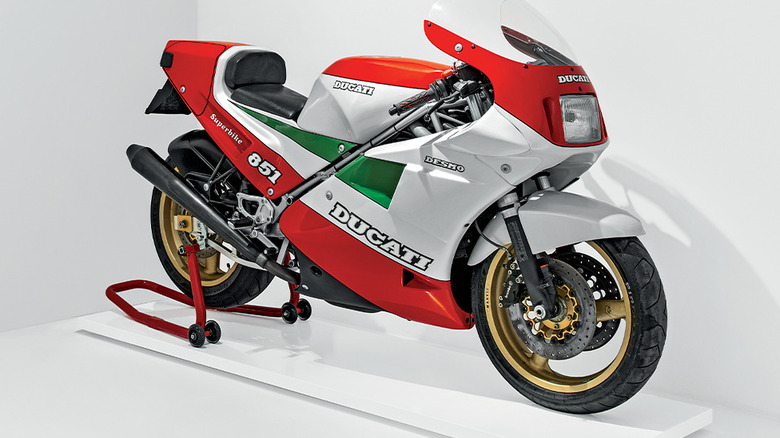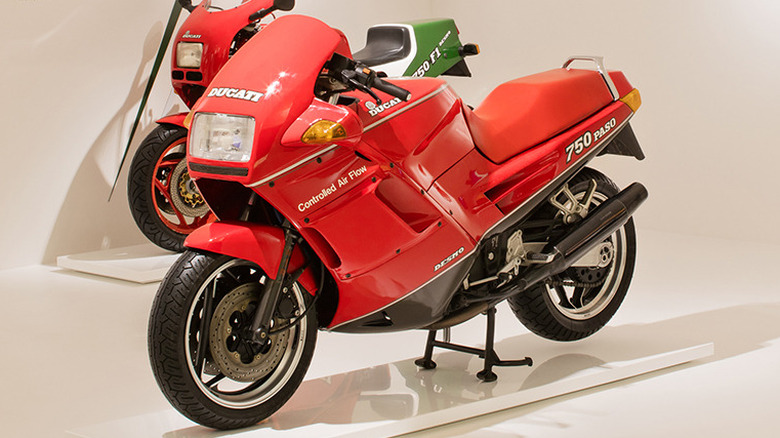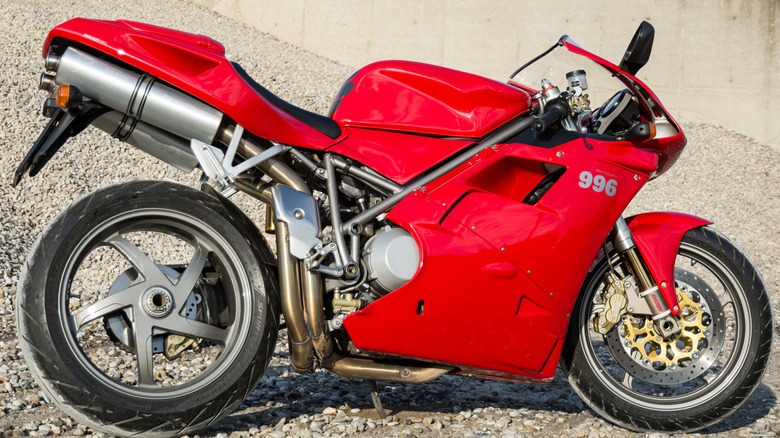11 Of The Best Looking Ducati Motorcycles On The Road Today
Ducati has long held a hallowed place in the hall of beautiful motorcycles. Like many motorcycle manufacturers, the Ducati firm began as an industrial concern with a focus other than motorcycles. The Ducati brothers, Adriano, Bruno, and Marcello, belonged to the same radio society in the early 20th century. They teamed up to start a company that manufactured radio and electrical components in 1926. The company ran strong out of Bologna, Italy, until a bombing raid in 1944 damaged the factory.
The brothers decided to reopen in 1945, this time focusing on developing Ducati's first motorcycle, the Puppy (Cucciolo in Italian). Ducati's inaugural effort was puppy-like indeed. More of a motorized bicycle with its 48cc engine, the Cucciolo nonetheless kicked off an era. By 1949, the Ducati 60 had arrived. The 60 is often considered the first official Ducati motorcycle.
Ducati has not looked back since. Today, the firm continues to build some of the planet's finest blends of style and speed. Developing a motorcycle at Ducati is a delicate balance of art and science, and the brand has always kept its eye on both equally. The result is a range of stylish, performance-oriented motorcycles produced for 75 years, one of the most design-oriented motorcycle builders in history. Join us in celebrating the legacy of this great Italian motorcycle maker and explore 10 of the most stylish Ducatis ever designed. Let's take a journey through Ducati's history and appreciate the beauty and innovation that has defined this iconic brand.
Ducati 175T
When Ducati needed a bike to showcase everything its factory could do, there was no way it would be ugly. The 175T, shined up in a museum display, looks like a piece of candy waiting to be eaten. Even back in the late 1950s, it's clear the company's goal was to engineer something beautiful. And the 175T was much more than beautiful.
Ducati factory riders Leopoldo Tartarini and Giorgio Monetti slung legs over the 175T on a 37,200 mile (60,000 km) journey. That's a lot to ask of any 175cc motorcycle. Monetti and Tartarini hit five continents and thirty-six countries on their grand tour. It was a publicity stunt, and it worked. The pair of riders departed on September 30, 1957 and returned on September 5, 1958.
The run on the 175T showcased that while it might look as delicate as spun sugar, the 14 hp single-cylinder engine would not quit. It may not measure up to the best Ducati motorcycles of today, but the 175T was proof of what was to come.
The real question is whether any are on the road today. While finding the 175T model specifically may be difficult, the price bug hasn't bitten Ducatis of that era — a 1958 Ducati 175 Sport sold for a mere $5,000 two years ago. While the little Ducati won't keep up with modern traffic, you may see one in the local parking lot at that price.
Ducati 750SS Desmo
The 750cc displacement has long been a popular motorcycle size. It is big enough to satisfy expert riders while nurturing (to a degree) intermediate riders. Ducati has made 750cc motorcycles for decades, but the early 1970s Super Sport models are works of art.
The Desmo alludes to the engine's desmodromic valve system, which Ducati has used since the 1950s. Instead of using a typical return spring in the valve train, a second cam and actuator close the valve. Complex though it was, in the '50s, it allowed engines to rev higher. Today, that is not the case, but a Ducati desmodromic engine is sort of like the work of a fine watchmaker that you can ride.
The 750SS debuted in 1973 with a 90-degree V-twin 748cc engine. With 73 hp, a sweeping half-fairing, and the track-racing solo seat, it looks like a race machine. The 750SS was not born alone. Ducati built a fleet of 750s through the 1970s, each with its own quirks and designations. It includes some of the most stylish Ducati motorcycles ever designed in its 1970s 750 family.
Ducati's 750 family, including the SS, seems alive and well on the roadways and in the auction houses. With an average price of $23,624 and a top sale price of $49,280, it remains well within street-able value. But beware — it'll initiate a conversation with anyone interested in motorcycles or sculpture.
[Featured image by Matti Blume via Wikimedia Commons | Cropped and scaled | CC BY-SA 4.0]
Ducati Monster 900
Some bikes cover everything with sleek fairings, but Ducati knows there is a time and place to show off the guts, especially when they are as beautiful as the Monster's. The Ducati Monster has been the epitome of the naked street fighter since its debut in 1994. That is a lot of pedigree for a bike still readily available in 2025.
Ducati makes a big deal of its trellis frame. It is not Ducati's sole trademark, but perhaps no other manufacturer makes the frame such a showpiece. The modern Monster SP looks more like its namesake than the original 1990s iterations. It is menacing and angular and currently sports a 937cc liquid-cooled twin-cylinder Testastretta engine.
Ducati is one of the few keeping it original in the mass-production motorcycle game. The SP claims 111 horsepower, but if you prefer a gentler generation, go back a few years. Like the 750SS, the Monster is part of an entire ecosystem, all naked street sport bikes showing off that framework. It makes one want to run fingers over the welds.
One exciting thing about Ducati is that the company is idiosyncratic. It makes everything from dirt bikes to MotoGP bikes. However, we argue that the Ducati naked street bikes are the brand's core. Like the 175T, the Monster is out there to get attention and show just what Ducati can do.
Ducati Desmosedici RR
We found it! If any road-going motorcycle can claim to be a red Light Cycle from Tron, it is the Desmosedici RR. This thing is dripping with Italian designs. For a road-going motorcycle, it is about as race-oriented as it gets, even from Ducati. It was first imagined as a full-fairing sport machine with a 998cc four-stroke V4 engine making 200 hp. Aside from being outrageously powerful and an authentic Ducati, the bike looked like it had been poured into its fairings, a design commitment that still remains after years of production.
The Desmosedici RR's 1,500-bike production run had an MSRP of $65,000. It came with a single seat, which reminds us why it is sometimes still referred to as a saddle, Ohlins forks, and Brembo brakes.
The entire project was modeled in homage to the 2006 World Championship-winning racing prototype. That, plus the saddle, ought to communicate everything you need to know about what this motorcycle is for. Kelly Blue Book marks a Desemodici RR in good condition as worth around $43,000. People spend way more money on toys that are far less cool.
[Featured image by Pierrecol via Wikimedia Commons | Cropped and scaled | CC BY-SA 3.0]
Ducati 450 Scrambler
This little Ducati reminds us of "The Talented Mr. Ripley" in all the best ways. Stylish and powerful without being threatening, it may be capable of more than you think. Unsurprisingly, the Scrambler 450 has earned a place in the hearts of Ducati fans.
First appearing in 1969, the single-cylinder 450cc looked like it should have Husqvarna or Bultaco painted on the side. But it was a Ducati, and it could be nothing else. With a gently sweeping chrome tank and one-piece seat for you and your signora or signor, it came with knobby tires equally adept at city streets as trails (that is to say, not adept at either) and a sense of adventure.
The styling shines. Fans of vintage motorcycles, not to mention Ducatis, can have a lot of fun on a Scrambler, whether in a garage in Staten Island or on a clifftop road on an Italian island. Ducati has used the Scrambler nameplate to play around over the years, shifting away from true scrambling duties to cafe racers and desert editions.
The original iteration disappeared around 1974, but we still think it is one of the best Ducatis to look at. It has also caught on in the used market more than some entries on this list. A top sale number of $80,000 is enough to raise an eyebrow. It is impossible to predict what will become popular, but maybe we will see Scramblers emerging from shacks and barns in the future.
Ducati Hypermotard
Some bikes are made to be put down a time or two. It is bound to happen to anyone who is around motorcycles long enough. Whether at speed or simply in the parking lot, a bike, especially one made for dipping and dodging around a supermoto track with what Ducati calls "the greatest agility," is bound to kiss the pavement once or twice. Except you really don't want the Hypermotard 950 to meet that fate. It is simply too beautiful.
A proper or budget-oriented rider may take a big-four dirtbike and slap some street tires and a suspension tweak on it before taking it to the track or the street. Owners of the Hypermotard 950 don't worry about that. They sling a leg over it in the garage, ride it in traffic to the track, whip it around the corner, and pop wheelies all night long. Then they ride it home.
The top-tier Hypermotard 950 SP gets a 937cc 114 horsepower engine with a bunch of included tools to tone it down: braking and traction controls, wheelie control, a quick shifter, and a six-axis inertial measurement unit (6D IMU). Wait. What was that last one?
The Hypermotard 950 is a Supermoto machine at heart. The 6D IMU measures the motorcycle's yaw, pitch, and roll, commanding the systems to work together for optimal performance and safety. Oh, and Ducati boasts that the saddle facilitates "longitudinal movement while riding." Any bike maker concerned with longitudinal movement has put a lot of thought into motorcycling.
Ducati Streetfighter V4 Lamborghini edition
The Ducati Streetfighter V4 is exceptional on its own, but teaming up with Lamborghini to develop a limited production collaboration was a stroke of genius. Despite all the red in Ducati's wardrobe, Ferrari wanted to build its own motorcycle. Fortunately for us, because it birthed the Streetfighter VR Lamborghini.
The bike debuted in 2022 with a limited production run of 630 units. While you likely won't see one on the road today, it could happen if you live near a collector. Keep an eye out for a Lamborghini in matching livery.
The monster green paint is utterly gorgeous. If the sculpted angles and bug-like headlights don't give it away, this is one unique bike at first glance. While there are certainly purists out there who disagree with everything about this motorcycle down to the molecular level, we're glad it exists.
The heart of the matter is a 1,103cc Desemosedici Stradale engine claiming a power output of 208 hp. The motorcycle is every bit as well-equipped as a Lamborghini, with an Ohlins smart suspension, Brembo brakes, and MotoGP wings for aero. It is best to class the Streetfighter as a two-wheeled Lambo. The original buyer even gets a limited-edition helmet and set of leathers that color-match the bike.
Ducati Panigale V4
No discussion of Ducati's best-looking motorcycles is complete without the Panigale. Ducati is a motorcycle designer that dabbles in the categories it finds interesting. In the same way the Hypermotard goes after the SuperMoto crowd, the Ducati aims the Panigale at the street and race course demographic.
The Panigale V4 is clearly a track weapon at first glance, but lights and signals are tucked into its devilish angles and curves. Of course, there is a track-only configuration, too. The Panigale V4 is a premium superbike from one of the world's finest constructors. It has a 998cc Desmosedici Stradale R Evo engine with a claimed maximum power figure of 237 hp.
Everything about the Panigale V4 is race-oriented, from its chassis to its electronics. The rider triangle is not geared toward comfortable riding; instead, it manhandles the rider into race position like a cross between a restaurant high chair and an arcade MotoGP racing game.
The dashboard display is bright and can be as complex as a Formula 1 steering wheel. It is the best Ducati has to offer, wrapped up in elite Italian fashion. It is not the motorcycle for the inexperienced or the shallow-pocketed. Nor should it be used in the commission of any private or unseemly activities — it will attract attention. And it should.
[Featured image by Matti Blume via Wikimedia Commons | Cropped and scaled | CC BY-SA 4.0]
Ducati 851 Tri Colore
Tricolore in an Italian flag. The 851 has a special place in the history of Ducati sport bikes, but our favorite is the 1987 special edition draped in patriotism.
The Ducati 851 arrived for the 1988 model year to replace the Ducati 750 F1, and it was more than a pretty face. Ducati may have caught attention with the red, white, and green, but the bike beneath was a masterpiece. Aside from the early '90s aesthetic that has aged so gracefully, this was a special edition Ducati! The 851cc V-twin made 119 hp. Marzocchi suspension and wheels combined with Brembo brakes to put the bike where it needed to go.
Ducati built 851s for a few years, and each generation looks as good or better than the previous. For the deep aficionado with a few Ducatis in the garage, picking up an 851 could look mighty attractive, but it would probably help to be a competent mechanic. Parts and processes from manufacturers like Ducati can be difficult to come by.
The 851s don't seem to have caught on. The market for 1987 Ducatis claims an average cost of $11,154 and a top sale of $17,920. That is not restrictively priced, certainly not for one of the best-looking Ducati motorcycles on the road today.
Ducati 750 Paso
The Paso 750 marks an important transition in Ducati's design history as one of the early full-fairing sport motorcycles to hit the street. The 750 was home territory for Ducati. It developed an excellent reputation building them, which meant the new model introduced in 1986, the Paso, had enormous shoes to fill.
The bike served admirably. It established the famous Ducati red and served as a canvas upon which designer Massimo Tamburini could work. But the Paso would not stay a 750 forever, later adopting larger engines. It wouldn't even stay in production for long. After about five years, it melted into the slipstream of Ducati's history, but not before leaving us with a few unique editions.
The Paso represents an era in motorcycle building just after the first wave of a massive sea change crashed ashore. The full-fairing revolution changed a lot more than what we see when we look at a motorcycle, and the Paso is a gorgeous example of a moment in motorcycle history when the race bikes put on their clothes and got down to business.
Ducati 996
There are few better entries on the cool resume than being the motorcycle from "The Matrix." Everything about "The Matrix: Reloaded" was mind-blowing. The stunts, the CGI, the action, and the main event: a Ducati 996 launching from the roof of a car carrier. Not that anyone should do that under any circumstances, but even suggesting doing it to a 996 should be some crime.
The 996 first appeared in 1999 as the perfect combination of gorgeous fairing and tubular trellis. It is among the first things people think of when they hear Ducati. It is angular, flowing, curved, and sharp in all the right places. It is also somewhat polarizing, as all art should be.
Ducati built a machine squarely in the shared space of a Venn diagram marked "beauty" and "performance." The 996 will look both new and ancient in a hundred years.
With a 996cc liquid-cooled V-twin that does not equip it for jumping off trucks or engaging in any shenanigans, the 996 is somewhat affordable for what is already an icon. The average used value is around $18,500, with a top sale of $54,654.
